コスモシールCholester は、コレステロール由来の固定相構造を有するためC18 カラムで分離できない化合物に対し分離を改善できる逆相クロマトグラフィー用カラムです。今回はC18 カラムでは分離できないコーヒーの有効成分の分析例をご紹介します。
(440KB)
コスモシールCholester は、コレステロール由来の固定相構造を有するためC18 カラムで分離できない化合物に対し分離を改善できる逆相クロマトグラフィー用カラムです。今回はC18 カラムでは分離できないコーヒーの有効成分の分析例をご紹介します。
(440KB)
| StemCulture | StemBeads FGF2 |
| ナカライテスク | 細胞保存液 Cell Reservoir One(ガラス化法用) |
| Tocris | 幹細胞研究関連試薬 |
| LifeSensors | モノユビキチン化ペプチド |
| InvivoGen | ワクチンアジュバント |
| Atlas Antibodies | ヒト細胞 / 組織染色用抗体 |
| Biotium | Mix-n-Stain™ Antibody Labeling Kit |
| Santa Cruz | モノクローナル抗体 新製品 |
| ナカライテスク | りん酸緩衝生理食塩水(KCl 不含)(pH 7.2) |
| ナカライテスク | COSMOSIL® 2.5HILIC |
親水性相互作用クロマトグラフィーは、親水性化合物を高感度分析する手法として注目されています。弊社では、コスモシール HILIC をラインアップしています。コスモシール HILIC を用いた分析例をご紹介します。
他の分析例についてはWeb site(http://www.nacalai.co.jp/cosmosil/data/csmosrchtop.cfm)で公開していま
すので、ご参照ください。
(583KB)
このたび発売しました3C18-EB は、従来のC18 カラムとは全く異なるエンドキャップ処理を施すことにより残存シラノールに対して高い遮蔽効果が得られる様になりました。このことにより塩基性化合物に対して従来のカラムと比較しても非常に良好なピーク形状となります。また簡便な合成スキームを採用することにより合成再現性に優れ、優れた分析再現性を実現しました。
(429KB)
弊社培地の製品を識別しやすくするためにラベルの表記方法を変更しました。
下記の対象製品について、順次変更を実施しています。
| 現行ラベル | 新ラベル | |
|---|---|---|
| 製品ラベル |  |
|
| グルコース濃度 | ・製品名の下に小さく記載 | ・『High / Low / No Glucose』までを製品名として記載→① |
| 含/不含成分 | ・特徴的な成分のみをwith/withoutで列記 | ・同培地の製品群で含/不含となる成分を全て 〇/×で表記 →② ・同培地では表記成分(順序) を固定→② |
| 文字サイズ | ・縮小( 記載情報増加のため) | |
| 空欄 | ・変更なし→③ 開封日などお客様のメモとして利用できます。 |
■液体培地
| 培地名 | Glucose | L-Gln | Phenol Red | HEPES | Sodium Pyruvate | others | 製品番号 | 容量 |
|---|---|---|---|---|---|---|---|---|
| DMEM | High | ○ | ○ | × | × | 08459-35 | 500 ml | |
| 08459-06 | 6x500 ml | |||||||
| High | ○ | ○ | × | ○ | 08458-45 | 500 ml | ||
| 08458-74 | 6x500 ml | |||||||
| High | × | ○ | × | ○ | 11584-85 | 500 ml | ||
| High | ○ | ○ | ○ | × | 08457-55 | 500 ml | ||
| High | × | ○ | ○ | × | 11585-75 | 500 ml | ||
| High | × | ○ | × | × | 08488-55 | 500 ml | ||
| High | × | × | × | × | 08489-45 | 500 ml | ||
| Low | ○ | ○ | × | ○ | 08456-65 | 500 ml | ||
| 08456-94 | 6x500 ml | |||||||
| Low | × | × | × | ○ | 08490-05 | 500 ml | ||
| No | ○ | ○ | × | × | 09891-25 | 500 ml | ||
| DMEM/F-12 | ○ | ○ | ○ | × | ○ | 11581-15 | 500 ml | |
| ○ | ○ | ○ | ○ | ○ | 08460-95 | 500 ml | ||
| ○ | × | ○ | ○ | ○ | 11583-95 | 500 ml | ||
| ○ | ○ | × | ○ | ○ | 05177-15 | 500 ml | ||
| ○ | ○ | × | × | ○ | 11582-05 | 500 ml | ||
| No | ○ | ○ | × | ○ | 09893-05 | 500 ml | ||
| Ham's F-12 | ○ | ○ | ○ | - | ○ | 17458-65 | 500 ml | |
| MEM | ○ | ○ | ○ | × | - | 21442-25 | 500 ml | |
| ○ | ○ | ○ | × | - | 非必須アミノ酸含有 | 21443-15 | 500 ml | |
| No | ○ | ○ | × | - | 非必須アミノ酸含有 | 09848-05 | 500 ml | |
| α-MEM | ○ | ○ | ○ | - | ○ | 21445-95 | 500 ml | |
| ○ | ○ | ○ | - | ○ | ヌクレオシド含有 | 21444-05 | 500 ml | |
| IMDM | ○ | ○ | ○ | ○ | ○ | 11506-05 | 500 ml | |
| RPMI1640 | ○ | ○ | ○ | × | - | 30264-85 | 500 ml | |
| 30264-14 | 6x500 ml | |||||||
| ○ | ○ | ○ | ○ | - | 30263-95 | 500 ml | ||
| ○ | × | ○ | × | - | 05176-25 | 500 ml | ||
| ○ | ○ | × | × | - | 06261-65 | 500 ml | ||
| No | ○ | ○ | × | - | 09892-15 | 500 ml |
○:含有 / ×:不含 / -:各培地の構成成分ではない成分
■平衡塩類
| 平衡塩名 | Ca・Mg | Phenol Red | 製品番号 | 容量 |
|---|---|---|---|---|
| ハンクス平衡塩溶液 | ○ | ○ | 17459-55 | 500 ml |
| × | ○ | 17460-15 | 500 ml | |
| × | × | 17461-05 | 500 ml | |
| ○ | × | 09735-75 | 500 ml | |
| D-PBS(-) | × | - | 14249-95 | 500 ml |
| 14249-66 | 6x500 ml | |||
| D-PBS(-) (10x) | × | - | 11482-15 | 500 ml |
| 平衡塩名 | KCl | 製品番号 | 容量 |
|---|---|---|---|
| PBS(-) pH7.2 | × | 11480-35 | 500 ml |
○:含有 / ×:不含 / -:各平衡塩類の構成成分ではない成分
20S、26Sプロテアソーム、COP9シグナロソーム、プロテアソーム基質
20S Proteasome (Human)
Quantity: 50 μg, 0.5mg/ml
Buffer: 20 mM Tris-HCl pH 7.2, 10% Glycerol, 150 mM KCl, 1 mM β–mercaptoethanol.
Source: Human red blood cells
Storage: -80o C. Avoid repeated freeze/thaw cycles
20S proteasome was purified from human blood cells by DEAE chromatography follow by the ammonium sulfate precipitation (60%), Mono Q and Resource Q chromatography. Purified complex was resolved on 10% SDS polyacrylamide gel and stained with Coomassie blue.
|
The chymotrypsin-like activity of the 20S proteasome (45μg/ml) was measured using 100μM Suc-LLVY-AMC in 20 mM HEPEs, pH 7.5, 0.5 mM EDTA, 0.05% Triton X, plus or minus 0.035% SDS |
The chymotrypsin-like activity of the 20S proteasome (18 μg/ml) was measured using 100μM Suc-LLVY-AMC in 20 mM HEPEs, pH 7.5, 0.5 mM EDTA, 0.05% Triton X, plus or minus 0.5 mM MG132 (Cat. # SI9710) |

| Product Name | Cat # | Vol. |
| 20S Proteasome (Human) | PS020 | 50 μg (0.5mg/ml) |
26S Proteasome (Human)
Quantity: 25μg, 50μg, 0.5mg/ml
Buffer: 20 mM Tris-HCl pH 7.2, 10% Glycerol, 150 mM KCl, 1 mM β–mercaptoethanol.
Source: Human red blood cells
Storage: -80oC. Thaw the vial on ice. Avoid repeated freeze/thaw cycles
26S was purified from human blood cells by DEAE chromatography follow by the ammonium sulfate precipitation (60%), Mono Q and Resource Q chromatography. Purified complex was resolved on 10% SDS polyacrylamide gel and stained with Coomassie blue.
| The chymotrypsin-like activity of the 26S proteasome (45μg/ml) was measured using 100μM Suc-LLVY-AMC in 20 mM HEPEs, pH 7.5, 0.5 mM EDTA, 0.05% Triton X, plus or minus 0.035% SDS | The chymotrypsin-like activity of the 26S proteasome (18 μg/ml) was measured using 100μM Suc-LLVY-AMC in 20 mM HEPEs, pH 7.5, 0.5 mM EDTA, 0.05% Triton X, plus or minus 0.5 mM MG132 (Cat. # SI9710) |
| Product Name | Cat # | Vol. |
| 26S Proteasome (Human) | PS026 | 25μg (0.5mg/ml) |
| 50μg (0.5mg/ml) |
COP9 Signalosome Complex (CSN, Human)
Quantity: 10 μg
Buffer: 20 mM Tris-HCl pH 7.2, 10% Glycerol, 150 mM KCl, 1 mM β–mercaptoethanol.
Source: Human red blood cells
Storage: -80oC. Avoid repeated freeze/thaw cycles
CSN complex was purified to homogeneity from human red blood cells using DEAE, Mono Q and Resource Q chromatography. Final fraction was resolved on 10% SDS polyacrylamide gel and stained with Coomassie blue (A). This preparation retains deneddylase activity (B)
| Product Name | Cat # | Vol. |
| COP9 Signalosome Complex (CSN, Human) | CP009 | 10 μg |
Rpn1 Protein (26S Proteasome Regulatory Subunit 1)
Quantity: 50 μg
Molecular weight: 109.5kDa
Tag: His6
Buffer: 20 mM sodium phosphate pH 7.4, 500 mM NaCl, 200 mM imidazole, 1mM β– mercaptoethanol.
Source: Yeast recombinant, expressed in E. coli. Accession number P38764.
Storage: -80oC. Avoid repeated freeze/thaw cycles
Recombinant Rpn1 protein (Hisx6 tag) was expressed in E.coli and purified on the Ni-NTA resin using a standard protocol. 5ug of purified protein was resolved on 10% PAGE and stained with Coomassie blue.
| Product Name | Cat # | Vol. |
| Rpn1 Protein (26S Proteasome Regulatory Subunit 1) | PS110 | 50 μg |
Rpn2 Protein (26S Proteasome Regulatory Subunit 2)
Quantity: 50 μg
Molecular weight: 104.2kDa
Tag: His6
Buffer: 20 mM sodium phosphate pH 7.4, 500 mM NaCl, 200 mM imidazole, 1mM β– mercaptoethanol.
Source: Yeast recombinant, expressed in E. coli. Accession number P32565.
Storage: -80oC. Avoid repeated freeze/thaw cycles
Recombinant Rpn2 protein (Hisx6 tag) was expressed in E.coli and purified on the Ni-NTA resin using a standard protocol. 5ug of purified protein was resolved on 10% PAGE and stained with Coomassie blue.
| Product Name | Cat # | Vol. |
| Rpn2 Protein (26S Proteasome Regulatory Subunit 2) | PS120 | 50 μg |
Suc-Leu-Leu-Val-Tyr-AMC (Suc-LLVY-AMC), Proteasome Substrate
Quantity: 5mg
Molecular weight: 763.9
Formula: C40H53N5O10
State: Lyophilized powder
Purity: >98% by TLC
Solubility: DMSO at least 5mM. Concentration range 10-100μM.
Storage: Dry reagent at 4oC; Store DMSO stock at -20oC. Avoid repeated freeze/thaw cycles
Formula:
| Product Name | Cat # | Vol. |
| Suc-Leu-Leu-Val-Tyr-AMC (Suc-LLVY-AMC), Proteasome Substrate | PS500 | 5mg |
超高感度!微量サンプルでも測定可能

VeriKine-HSTM Human Interferon Beta Serum ELISA Kit
• Allows accurate Human IFN-β measurement to as low as 1.2 pg/ml
• Compatibles with human serum, plasma, autoimmune disease sera, or cell culture media
• Provides high precision assay reproducibility with < 8% inter-assay CV
• Suitable for measurement of trademarked therapeutic molecules in human serum samples
Interferon beta (IFN-β) has long been known to function as an inhibitor of viral
replication as part of body’s innate antiviral response. It is also widely used as a
treatment for Multiple Sclerosis (MS) patients, either as a single agent or as part of a
combinatorial approach. With the resurgence of interest in antitumor immunity as a
promising treatment approach for several types of cancers, there has been renewed
focus on applying IFN-β as a therapy due to the anti-tumor and immunomodulatory
properties of the protein. In addition, ligation of Toll-Like Receptors (TLRs)
leads to IFN-β production and, as novel TLR agonists and antagonists are being
developed as therapeutics for several diseases, it may be useful to monitor IFN-β
level as a downstream readout for compound effectiveness.
The VeriKine-HSTM Human Interferon Beta Serum ELISA kit has been developed
to measure low or basal levels of human IFN-β in serum, plasma or tissue culture
media samples. This assay is also suitable for measurement of trademarked IFN-β
therapeutic compounds in human serum. Researchers and clinical investigators
examining a) the pharmacokinetics of IFN-β molecules, b) IFN-β as a biomarker,
or c) IFN-β as a pharmacodynamic marker of TLR agent or other immune response modifier activity will find this highly sensitive and specific assay to be an essential laboratory tool.
Dose Response in Normal Human Serum Spiked with 0, 1, 3, and 10 U/ml IFN-β

Correlation between ELISA Standard Curves prepared in Standard Diluent and Normal Human Serum


| Description | Package Size | |
| 41415-1 | VeriKine-HSTM Human Interferon Beta Serum ELISA Kit Compatibility: human serum, plasma, cell culture media plate Assay range: 1.2-150 pg/ml |
1 x 96-stripwell |
Kit Speci!cations:
• Assay range: 1.2-150 pg/ml
• Format: 96-stripwell plate
• Sample volume: 50 μl per well
• Detection: colorimetric
• Assay time: 3 hours
• Compatibility: human serum, plasma, or cell culture media
• Speci!city: human IFN-β. Does not cross-react with human IFN-α,
IFN-γ, IFN-ω, IL-6; no cross-reactivity with mouse IFN-α, IFN-β or Rat IFN-β
Kit Components:
• Precoated 96-stripwell plate
• Plate sealer
• Recombinant human IFN-β standard
• Wash solution concentration
• Standard diluent
• Sample buller
• Antibody concentrate
• HRP conjugate concentrate
• Assay diluent
• TMB substract solution
• Stop solution
USP7、USP14、USP19、USP9x ノックダウン HeLa 細胞
RNAi is the major approach for studying a targeted gene function with high specificity and selectivity as a reliable alternative to laborious knockout strategies.
LifeSensors is offering SilenciX®, gene-specific knock-down cell lines ‘silencing’ DUBs and/or other important proteins of interest using a unique siRNA delivery system developed by tebu-bio Laboratories*. Based on EBV-replication, SilenciX ensures chromosome-like replication without integration in the genome. Reinforced by an optimal hygromycin selection, this loss-of-function model comes with exceptional features determined by three major factors:
· Targeting - specific and efficient
· Stability - homogenous and constant knockdown
· No off-target effects - genome and transcriptome integrity
Main benefits:
SilenciX® employs a pEBV-derived plasmid delivery system designed to deliver optimal and constant siRNA levels without off-target effects (Biard, 2007). The Epstein-Barr (EBV)-based vector is anchored to chromosomes and replicates as a replicon without any integration in the genome. Reinforced by optimal hygromycin selection, the number of vectors is perfectly maintained. This avoids saturation of the RNAi machinery resulting in specific and homogeneous knockdown of the desired target.
Comparison to traditional RNAi approaches:
| siRNA | shRNA | SilenciX | |
| Human and rodent cell lines | |||
| Stability | 2-3 days | Several months | Several months; start each experiment with the same cell batch - just thaw the vial |
| Efficiency | >70% validation by qPCR | ||
| Production time | Few days, controlling each experiment | 5 weeks | 2/3 days |
| Reproducibility | no | Yes, with experience | High reproducibility, Homogeneous population |
Applications of specific knock-down cellular model using SilenciX® technology
PRODUCT INFORMATION
For each cell line, you receive:
• One vial of target specific SilenciX® cells
• One vial of control SilenciX® cells (transfected with a non-relevant shRNA sequence)
• Specification sheets with qPCR quality controls and details of shRNA sequence
• Complete user manual
References
Despras E, Pfeiffer P, Salles B, Calsou P, Kuhfittig-Kulle S, Angulo JF, Biard DS. Long-term XPC silencing reduces DNA double-strand break repair. Cancer Res. 2007 Mar 15;67(6):2526-34.
| Product Name | Cat No | Volume |
| USP14 HeLa SilenciX | SLX-00163 | 1 kit |
| USP19 HeLa SilenciX | SLX-00164 | 1 kit |
| USP7 HeLa SilenciX | SLX-00159 | 1 kit |
| USP9X HeLa SilenciX | SLX-00160 | 1 kit |
*SilenciX® is a registered trademark of tebu-bio; technology licensed from the CEA.
SUMO化酵素、脱SUMO化酵素、SUMO誘導体
Deconjugating Enzymes
| Product Name |
CATALOG# |
Volume |
| SENP1core | DB701 | 25 ug |
| SENP2core | 4020 | 250 unit |
| 500 unit |
||
| 1000 unit |
||
| 5000 unit |
||
| SENP6core | DB703 | 25 ug |
Deconjugating Enzyme Substrates
| Product Name | CATALOG# | Volume |
| SUMO1-AMC | SI420 | 50 ug |
| SUMO2-AMC | SI520 | 50 ug |
| SUMO2-aminoluciferin | SI560 | 50 ug |
| SUMO2-Rhodamine | SI530 | 50 ug |
Conjugating Enzymes
| Product Name | CATALOG# | Volume |
| SUMO E1 | SU101 | 25 ug |
| UBE2I, His6 (Ubc9) | UB228H | 3 nmoles |
SUMO
| Product Name | CATALOG# | Volume |
| SUMO-2 (human, recombinant) | SU202 | 500 ug |

New products are an essential component of our range. Introductions are made on an ongoing basis, with hundreds of new small molecules, peptides and antibodies being added every year. Our aim is to find the latest, otherwise unobtainable research tools, and bring them to the market as quickly as we can.
| Cat.No. | Product Name | Activity |
| 4846 | Apicidin | Histone deacetylase inhibitor |
| 4804 | APETx2 | ASIC3 channel blocker |
| 4791 | Candesartan | AT1 receptor antagonist |
| 4779 | GRI 977143 | Selective LPA2 agonist; antiapoptotic |
| 4748 | ML 221 | Apelin receptor (APJ) antagonist |
| 4571 | A 867744 | Positive allosteric modulator of α7 nAChR |
| 4811 | TAT 14 | Nrf2 pathway activator; blocks Nrf2/Keap1 interaction |
| 4792 | Candesartan cilexetil | Prodrug of candesartan, an AT1 receptor antagonist |
| 4755 | Q94 hydrochloride | Negative allosteric modulator at PAR1 receptor |
| 4751 | FSLLRY-NH2 | PAR2 peptide antagonist |
| 4746 | ML SA1 | Activator of TRPML channels |
| 4744 | P11 | Potent antagonist of αvβ3-vitronectin interaction; antiangiogenic |
| 4677 | CYM 50260 | Potent and selective S1P4 agonist |
| 4638 | Pam2CSK4 Biotin | Biotinylated Pam2CSK4 (Cat. No. 4637) |
| 4636 | Pam3CSK4 Biotin | Biotinylated Pam3CSK4 (Cat. No. 4633) |
| 4345 | TC-C 14G | Potent, high affinity CB1 receptor inverse agonist |
| 4012 | SR 140333 | Potent NK1 receptor antagonist |
| 3920 | AMG 548 | Potent and selective p38α inhibitor |
| 3839 | HPI 1 | Inhibits Hedgehog signaling |
| 4541 | SGC 0946 | Highly potent and selective DOT1L inhibitor; cell permeable |
TLR2かつ/またはTLR7に作用するアゴニスト

Toll-like receptors (TLRs) are the best studied pattern recognition receptors (PRRs) and their importance in stimulating innate and adaptive immunity is now well established.
TLRs are sensors of microbial components as well as host-derived endogenous molecules released by injured tissues. TLRs play a critical role in defense against invading pathogens but are also involved in other serious pathological processes, such as tumorigenesis [1]. In view of this, TLR agonists have great potential as immunotherapeutics or vaccine adjuvants for the treatment of infectious diseases, cancer and autoimmune diseases.

One of the most successful empiric vaccines ever developed, the live attenuated yellow fever vaccine YF-17D, activates immune cells via multiple TLRs [2]. In the same line, microbial products, such as Coley’s toxin (a mixture of killed Streptococcus pyogenes and Serratia marcescens bacteria) and Bacille Calmette-Guérin (BCG, an attenuated strain of Mycobacterium bovis), which have been used as anticancer agents with some success, induce the host immune system through the activation of several TLRs. Studies have demonstrated that YF-17D and BCG efficacy requires a Th1 cytokine response which promotes antigen-specific cytotoxic T cells [2, 3].
Today, very few TLR agonists are approved for clinical use as stand-alone agents or adjuvants [4]. One of the major challenges of cancer immunotherapy is the reversal of tumor-driven immune suppression. Tumor cells release soluble factors leading to tumor infiltration by immune cells and their convertion into potent immunosuppressive cells. Among the immune suppressor cells, myeloid-derived suppressor cells (MDSCs) are the focus of extensive studies. MDSCs release additional soluble factors that stimulate tumor growth, induce regulatory T cells and suppress CD8+ T cells, thus impairing tumor surveillance and antitumor responses [5]. TLR3 or TLR9 agonists, which elicit strong IFN-α responses, have been shown to induce MDSC maturation and loss of suppressive functions, in contrast to TLR4 agonists which support MDSC suppressive functions [6].

Schematic representation of innate immune signaling pathways activated by PamadiFectin™ (CL553), a multi-PRR agonist that activates TLR2, TLR7 and nucleic acid sensors when complexed with dsDNA, for example.
Given that TLRs are expressed in different cellular compar tments, by different cell types and that they trigger different signaling pathways, combining TLR agonists can act in synergy to promote Th1-type immunity. Encouraging clinical results have been reported with the combination of BCG and the TLR7 agonist Imiquimod in melanoma patients [7]. Furthermore, vaccination studies have demonstrated that the combination of Imiquimod and MPL, a TLR4 ligand, elicits synergistic increases in antigen-specific neutralizing antibodies compared to a single TLR ligand [8].
The combination of TLR agonists with agonists for other PRRs, such as the sensors of nucleic acids RIG-I/MDA-5, IFI16 and cGAS, may fur ther enhance the immune response against cancer and infectious diseases.
With this perspective, InvivoGen has developed multi-PRR agonists that activate TLR2 and/or TLR7 and can complex nucleic acids, such as double-stranded DNA, leading to additional recognition by cytosolic DNA sensors (CDSs). These molecules have been shown to induce a strong immune response in a murine melanoma cancer model and in vaccination studies.
By mimicking the potent natural immuno-stimuli that are viruses and bacteria, multi-PRR ligands represent an interesting new class of agents in cancer immunotherapy or vaccination. However, further studies are needed to develop the best PRR agonist combinations for a given application.
1. Rakoff-Nahoum S. & Medzhitov R., 2007. Regulation of spontaneous intestinal tumorigenesis through the adaptor protein MyD88. Science. 317(5834):124-7.
2. Querec T. et al., 2006. Yellow fever vaccine YF-17D activates multiple dendritic cell subsets via TLR2, 7, 8, and 9 tostimulate polyvalent immunity. J Exp Med. 203(2):413-24.
3. Saint F. et al., 2001. T helper 1/2 lymphocyte urinary cytokine profiles in responding and nonresponding patients after 1 and 2 courses of bacillus Calmette-Guerin for superficial bladder cancer. J Urol. 166(6):2142-7.
4. Galluzzi L. et al., 2012. Trial Watch: Experimental Toll-like receptor agonists for cancer therapy. Oncoimmunology. 1(5): 699–716.
5. Gabrilovich DI. et al., 2012. Coordinated regulation of myeloid cells by tumours. Nat Rev Immunol. 12(4):253-68.
6. Lindau D. et al., 2013. The immunosuppressive tumour network: myeloid-derived suppressor cells, regulatory T cells and natural killer T cells. Immunology. 138(2):105-15.
7. Kidner TB. et al., 2012. Combined intralesional Bacille Calmette-Guérin (BCG) and topical imiquimod for in-transit melanoma. J Immunother. 35(9):716-20.
8. Kasturi SP. et al., 2011. Programming the magnitude and persistence of antibody responses with innate immunity. Nature. 470(7335):543-7.
Multi-PRR Ligands Products
| Dual TLR Agonists | ||
| CL401 | TLR2 & TLR7 Ligand | 500 µg |
| Adilipoline™ (CL413) | TLR2 & TLR7 Ligand | 500 µg |
| CL531 | TLR2 & TLR7 Ligand | 500 µg |
| CL572 | Human TLR2 & mouse and humanTLR7 Ligand | 500 µg |
| TLR Agonists & Nucleic Acid Carriers | ||
| CL419 | TLR2 Ligand | 500 µg |
| AdiFectin™ (CL347) | TLR7 Ligand | 500 µg |
| PamadiFectin™ (CL553) | TLR2 & TLR7 Ligand | 500 µg |
 ナカライテスク32版総合カタログを発刊しました。32版カタログは「お役に立つ」「使い易い」をテーマに製品掲載数の増加や情報の拡大、そして見易すいカタログを目指し作成しました。
ナカライテスク32版総合カタログを発刊しました。32版カタログは「お役に立つ」「使い易い」をテーマに製品掲載数の増加や情報の拡大、そして見易すいカタログを目指し作成しました。
本カタログをより活用いただきたくとともに、今後とも弊社製品のご愛顧をよろしくお願い申し上げます。
● 約9,000容量追加
| 有機合成関連製品 | ライフサイエンス関連製品 | ||
|---|---|---|---|
| ArkPharm | :創薬研究用化合物 |
Tocris |
:神経、7TM、がん、生物医学系化合物 |
| Strem | :金属触媒、りん化合物、ナノマテリアル | Biotium | :蛍光関連試薬(二次抗体、標識化合物) |
| Apollo | :ふっ素化合物、有機中間体 | LifeSensors | :ユビキチン研究試薬、SUMOタグ発現システム |
| PepTech | :ボロン酸、ふっ素化合物、触媒等 | ||
● 抗体、ELISA Kit部分を表組み

● メリハリをつけた文字使用
発注や照会に必要な、英名、製品番号、容量単位、価格部分を太字にしました。
● 分野別特集ページのQRコード追加

タンパク質分離用イオン交換HPLC カラムのCOSMOGEL® IEX シリーズは、精製用カラム以外に精密分析用もラインアップしています。精密分析用カラムは、非常に高い分離能を有するため抗体医薬など抗体分析に有効なカラムとなります。今回、イオン交換カラムを用いたモノクローナル抗体の分析例の一部をご紹介します。
(478KB)
コスモシール3C18-EB は、医薬品成分など塩基性化合物に対してテーリングすることなくシャープなピーク形状が得られます。シャープなピーク形状により正確な定性・定量分析を可能にしたカラムです。今回は他社製品との比較と、医薬品の分析例をご紹介します。
(425KB)
コスモシールHILIC は、トリアゾールを結合した親水性相互作用クロマトグラフィー用カラムです。この固定相の効果により従来の親水性相互作用に加えて陰イオン交換能を有します。これにより広範囲の化合物に対して高分離を示します。この2つの相互作用の使い分け方法についてご紹介します。
こちら→
(365KB)
CBB-R250色素を採用したCBB Stain One Superを発売しました。汎用されているCBB-R250色素特有の青紫色のバンドで、従来のCBB Stain One(Ready To Use)と比較し染色バンドが見やすくなった1液タイプの染色液です。
弊社従来品のCBB Stain Oneと比較した場合、本製品は濃い色調のCBB-R250色素を採用したことにより、染色時間も短縮されています。また、Rapid Stain CBB kitと比較した場合、本製品は、1液タイプで調整の手間が不要かつ刺激性の強い酢酸も含まれていません。
| CBB Stain One Super (#11642) | CBB Stain One (#04543) | Rapid Stain CBB kit (#30035) |
|
|---|---|---|---|
| 色素 | CBB-R250 | CBB-G250 | CBB-R250 |
| 形状 |
・1液タイプ ・酢酸、メタノール不含 |
・1液タイプ
・酢酸、メタノール不含 |
・2液タイプ ・酢酸含有、メタノール不含 |
| 染色時間 | 30分 | 60分 | 20分 |
| 脱色時間 | 6時間~1晩 | 6時間~1晩 | 1晩 |
| 検出感度 | 数十ng | ||
本製品は、他社のR250色素を採用している製品と比較し、同等以上の感度や視認性が得られています。また、G250色素を採用している従来のCBB Stain Oneと比較し、感度は同等ですが、濃い色調で染色されるため視認性が高くなっています。

|
|||||||||||
本製品の使用方法の概要を示します。
 |
|||||
|
|||||
| 製品名 | 規格 | 貯法 | 製品番号 | 容量 | 価格 |
|---|---|---|---|---|---|
| CBB Stain One Super(Ready To Use) | SP | 室温 | 11642-31 | 1 L | 13,500 |
※記載の内容は、'13年3月現在の情報に基づいております。
*1細胞種、細胞密度によって培地交換の回数の調整が必要となります。
*2現時点で特定の培地に対する不具合は確認されていません。
StemBeadsで育てたiPS細胞やES細胞のコロニーは典型的な形態を示すことが実証されています。
データご提供:京都大学物質−細胞統合システム拠点 (iCeMS) 長谷川 光一講師、吉田 則子研究員
| ■ヒト iPS細胞株 253G1* |
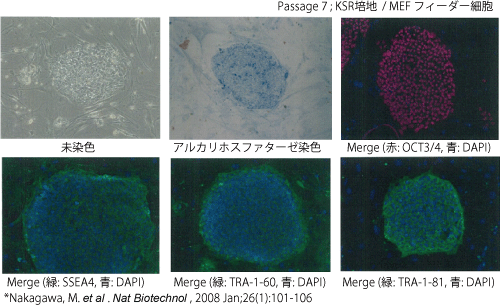 |
|
■ヒト ES細胞株 KhES-1 |
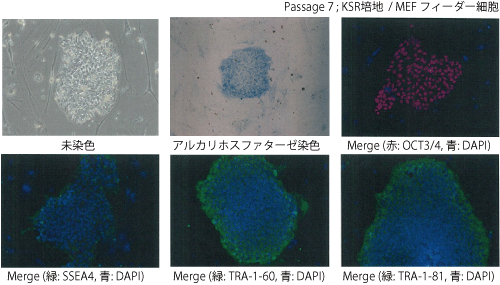 |
|
■ヒト ES細胞株 H9 |
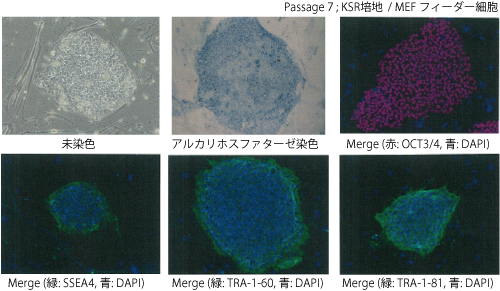 |
■FGF量の変化
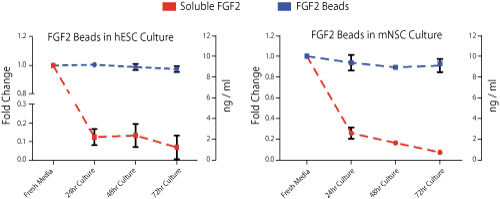 |
| 従来法によりFGF2を添加した場合、安定性の問題により、FGF2は激減します。StemBeadsを使用すると、3日間一定量でFGF2が徐放されます。 |
■従来法との未分化マーカーの発現量、核型解析、コロニー形態の比較
|
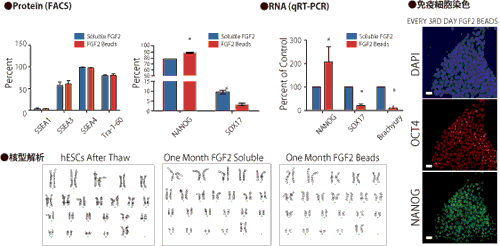
|
| MEFフィーダー細胞上で1ヶ月間培養したヒトES細胞のFACS解析では、本製品を添加した培地を3日に一度の培地交換により培養した細胞と従来法により培養した細胞で類似したプロファイルを示します。しかし、qRT-PCRの結果では、NANOGの発現量が著しく上昇し、分化マーカーのSOX17やBrachyuryは著しく減少しました。hESCの正常核型を増殖前に評価して、従来法または本製品使用による増殖後1ヶ月の細胞についても評価しました。その結果、いずれも、異常は確認されませんでした。免疫細胞染色では、本製品の使用と従来法を比較した結果、コロニーの形態や多能性マーカーであるOCT4、NANOGの発現量が類似していました。 |
■ 従来法とのマウス神経幹細胞における未分化状態維持の比較
|

|
| FGF2 Beadsは、マウスの神経幹細胞について未分化状態の維持に優れることが示されています。本製品を添加した培地を用い1週間培養したマウスの神経幹細胞は、従来法やFGF2を含まない場合と比較して前駆細胞(Nestin+)の数が上昇し、神経に分化した細胞(TUJ1+)の数が減少することが示されています(Scale bars=50microns)。 ここには掲載していませんが、ヒトの神経幹細胞でも同様の結果が得られています。 |
| ● 培地中に徐放されるFGF2の濃度はどの程度ですか? |
|
⇒培地1 mlに対し、7.5 µl のStemBeadsを混合した場合、FGF2の濃度は10 ng/ml です。実際のデータは前ページの性能評価1を参照ください。 |
|
● StemBeadsの細胞/コロニーへの付着が認められます。問題はありますか? |
|
⇒StemBeadsは生分解性ポリマーのPLGA [Poly(lactic-co-glycolic Acid)]から成りますので次第になくなり、細胞に悪影響はありません。 |
|
● StemBeadsの有効期限はどれくらいですか? |
|
⇒商品到着後、4℃保管で6ヶ月間はFGF2の活性は低下しません。 |
|
● StemBeadsはどのような細胞に適用できますか? |
|
⇒現時点では、ヒトES細胞、ヒト iPS細胞、マウスおよびヒト神経幹細胞での適用を確認しています。基本的に、Human FGF2を必要とする細胞には適用可能と考えます。 |
|
● 培地交換の操作は? |
|
⇒培地交換は、古い培地を除去後PBSで洗浄してから、新しい培地を加えます。 |
|
● StemBeadsの使用時は、培地が通常時よりも黄色に変色します。何か問題はありますか? |
|
⇒培地の交換頻度が少なく済むために、pHが早く変化して黄色に変色します。このような現象が起こっても、細胞の増殖能や分化に影響は与えませんが、避ける場合には低密度で細胞を播種してください。StemBeadsは低-中程度の細胞密度に最適化されています。 |
|
● ヒトES細胞やiPS細胞の融解後、直ぐにStemBeadsを用いて培養すべきですか? |
|
⇒融解した細胞は、より栄養を必要とするので、コロニーが形成されるまで毎日の培地交換をお勧めします。その培地交換でもStemBeadsを使用でき、コロニー形成が早くなります。 |
| 製品名 | メーカー製品番号 | 容量 | 価格 |
|---|---|---|---|
| StemBeads FGF2 | SB500 | 3.0 ml | 56,000 |
※記載の内容は、'13年3月現在の情報に基づいております。
本製品の使用により、CBB法において、高濃度の界面活性剤や塩類、変性剤を含む溶液のタンパク質定量が可能です。操作は簡単で、タンパク質沈殿法により、これらの妨害物質を除去でき、測定用サンプルの調製が可能です。
■SDS-PAGE用試料緩衝液に溶解しているタンパク質の定量
妨害物質である還元剤、界面活性剤を共に含む試料緩衝液中のタンパク質(BSA)を測定した結果を示します。A社除去キット使用時には、定量性が得られませんでしたが、本製品では定量性が得られており、除去効果が確認できました。
 |
以下に妨害物質の例を示します。水色の列は、直接サンプルをCBB法で測定しても影響を与えない妨害物質の最大濃度を示し、紫色の列は本製品を使用した場合の最大濃度を示しています。界面活性剤、変性剤、塩類では妨害物質の影響が大幅に減少しています。
*キレート剤含有または酸性溶液(pH約5以下)の場合、中和もしくは表記載濃度まで希釈してからご使用ください。
使用前に製品添付文書をご参照ください。
| 妨害物質 | 直接 CBB法 | 本製品使用時 | 妨害物質 | 直接 CBB法 | 本製品使用時 |
|---|---|---|---|---|---|
| 界面活性剤 | 変性剤 | ||||
| Brij35 | 0.05% | 7.5% | Ammonium Sulfate | 2M | 1M |
| NP-40 | 0.05% | 10% | Arginine・Na | 2M | 2M |
| Octylβ-glucoside | 1% | 15% | Guanidine・HCl | 1M | 6M |
| Octylβ-thioglucopyranoside | 1% | 15% | Urea | 4M | 8M |
| Triton®X-100 | 0.1% | 15% | Thiourea | 2M | 2M |
| Tween®-20 | 0.05% | 15% | Buffer | ||
| CTAB | 0.005% | 2% | Glycine pH2.8 | 1M | 0.1mM* |
| Deoxycholic Acid | 0.025% | 7.5% | HEPES pH7.5 | 0.5M | 1M |
| SDS | 0.01% | 2% | MES pH6.1 | 1M | 1M |
| CHAPS | 0.5% | 15% | MOPS pH7.2 | 1M | 1M |
| CHAPSO | 0.5% | 15% | PBS | 5X | 5X |
| 還元剤 | Sodium Acetate pH5.2 | 0.75M | 1.5M | ||
| DTT | 0.5M | 0.5M | Sodium Bicarbonate | 0.25M | 0.5M |
| 2-Mercaptoethanol | 5M | 1.25M | TBS;Tris(25mM),NaCl(137mM) | 5X | 5X |
| TCEP pH7.6 | 0.25M | 0.25M | Tris-HCl pH8 | 2M | 4M |
| Glutathione pH7 | 125mM | 125mM | その他 | ||
| キレート剤 | KCl | 1M | 4M | ||
| EDTA | 0.25M | 25mM* | NaCl | 1.25M | 5M |
| EGTA | 0.25M | 5mM* | MgCl2 | 0.5M | 4.5M |
| Sodium Citrate | 0.25M | 100mM* | HCl | 0.1M | 10mM* |
本製品を加え遠心操作を行う事で、タンパク質を沈殿させ、妨害物質を除去します。沈殿後のタンパク質にプロテインアッセイCBB溶液を直接添加する事で、定量が可能です。
尚、本製品により0.2~1.0mg/ml濃度のタンパク質溶液を沈殿できます。
*詳細は製品添付文書をご参照ください。
| 製品名 | 規格 | 貯法 | 製品番号 | 容量 | 価格 |
|---|---|---|---|---|---|
| Protein Assay CBB Clean Up Kit | SP | 室温 | 11611-60 | 1 kit(250回) | 9,300 |
※記載の内容は、'13年3月現在の情報に基づいております。
超高感度!微量サンプルでも測定可能

VeriKine-HSTM Human Interferon Beta Serum ELISA Kit
• Allows accurate Human IFN-β measurement to as low as 1.2 pg/ml
• Compatibles with human serum, plasma, autoimmune disease sera, or cell culture media
• Provides high precision assay reproducibility with < 8% inter-assay CV
• Suitable for measurement of trademarked therapeutic molecules in human serum samples
Interferon beta (IFN-β) has long been known to function as an inhibitor of viral
replication as part of body’s innate antiviral response. It is also widely used as a
treatment for Multiple Sclerosis (MS) patients, either as a single agent or as part of a
combinatorial approach. With the resurgence of interest in antitumor immunity as a
promising treatment approach for several types of cancers, there has been renewed
focus on applying IFN-β as a therapy due to the anti-tumor and immunomodulatory
properties of the protein. In addition, ligation of Toll-Like Receptors (TLRs)
leads to IFN-β production and, as novel TLR agonists and antagonists are being
developed as therapeutics for several diseases, it may be useful to monitor IFN-β
level as a downstream readout for compound effectiveness.
The VeriKine-HSTM Human Interferon Beta Serum ELISA kit has been developed
to measure low or basal levels of human IFN-β in serum, plasma or tissue culture
media samples. This assay is also suitable for measurement of trademarked IFN-β
therapeutic compounds in human serum. Researchers and clinical investigators
examining a) the pharmacokinetics of IFN-β molecules, b) IFN-β as a biomarker,
or c) IFN-β as a pharmacodynamic marker of TLR agent or other immune response modifier activity will find this highly sensitive and specific assay to be an essential laboratory tool.
Dose Response in Normal Human Serum Spiked with 0, 1, 3, and 10 U/ml IFN-β

Correlation between ELISA Standard Curves prepared in Standard Diluent and Normal Human Serum


| Description | Package Size | |
| 41415-1 | VeriKine-HSTM Human Interferon Beta Serum ELISA Kit Compatibility: human serum, plasma, cell culture media plate Assay range: 1.2-150 pg/ml |
1 x 96-stripwell |
Kit Speci!cations:
• Assay range: 1.2-150 pg/ml
• Format: 96-stripwell plate
• Sample volume: 50 μl per well
• Detection: colorimetric
• Assay time: 3 hours
• Compatibility: human serum, plasma, or cell culture media
• Speci!city: human IFN-β. Does not cross-react with human IFN-α,
IFN-γ, IFN-ω, IL-6; no cross-reactivity with mouse IFN-α, IFN-β or Rat IFN-β
Kit Components:
• Precoated 96-stripwell plate
• Plate sealer
• Recombinant human IFN-β standard
• Wash solution concentration
• Standard diluent
• Sample buller
• Antibody concentrate
• HRP conjugate concentrate
• Assay diluent
• TMB substract solution
• Stop solution